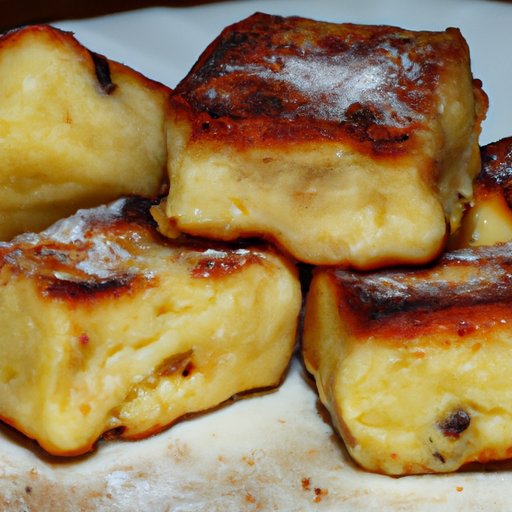
Introduction
Fried bread, a staple in many cultures, is a beloved dish that can be enjoyed as a side dish or in its own right. From Native American fry bread to Indian poori, fried bread takes many forms and can be served with a variety of toppings. In this article, we’ll provide you with a step-by-step guide on how to make fried bread, explore healthier versions of the dish, share creative variations, and delve into its cultural significance.
Step-by-Step Recipe Guide
To make fried bread, you’ll need the following ingredients:
- 2 cups all-purpose flour
- 2 teaspoons baking powder
- 1/2 teaspoon salt
- 1 cup milk
- Oil for frying (vegetable oil is recommended)
Here’s how to make it:
- In a bowl, mix together flour, baking powder, and salt. Gradually add milk while mixing until dough forms.
- Knead the dough on a floured surface until it becomes smooth and elastic.
- Divide the dough into 8-10 equal pieces and roll each piece into a ball.
- On a floured surface, flatten each ball into a 4-5 inch circle.
- Heat oil in a heavy-bottomed saucepan or deep fryer until it reaches 350-375 degrees Fahrenheit.
- Gently place the flattened dough into the hot oil and cook for 1-2 minutes on each side, or until golden brown.
- Remove the fried bread using a slotted spoon and place it on paper towels to drain excess oil.
For best results, serve the fried bread immediately while it’s still warm and crispy. You can top it with savory or sweet toppings, such as shredded cheese, refried beans, or honey and cinnamon.
Healthier Fried Bread Options
If you’re looking for a healthier version of fried bread, there are several options available. For instance, you can use whole wheat flour instead of all-purpose flour for a more fiber-rich option. Alternatively, you can use alternative flours, such as almond or coconut flour, to create a gluten-free recipe.
To make a gluten-free fried bread, you’ll need the following ingredients:
- 2 cups almond flour
- 2 teaspoons baking powder
- 1/2 teaspoon salt
- 2 large eggs
- 1/4 cup unsweetened almond milk
- Oil for frying
Follow the same instructions outlined for the original recipe, but swap out all-purpose flour for almond flour and milk for almond milk. Fry it as usual and enjoy a healthier twist on traditional fried bread.
Fried Bread Variations
While fried bread is delicious on its own, you can add a variety of flavors to the dough for a creative twist. For example:
- Add chopped herbs, such as basil or rosemary, to the dough for a savory variation.
- Spice up the dough with a pinch of garlic powder, cumin, or paprika for an extra kick.
- Add a filling, such as ground meat or cheese, to the center of the dough and fold it over before frying for a stuffed version of fried bread.
Don’t be afraid to experiment with different flavors and textures. With fried bread, the possibilities are endless!
Cultural Context
Fried bread has a rich history across many cultures, often serving as a staple food or special occasion dish. In Native American cuisine, fry bread is a popular festival food. In New Zealand, a similar dish called “fry bread” is served at Maori ceremonies. In India, poori is a fried bread that is enjoyed with spicy curries.
The preparation and serving of fried bread varies widely across different cultures, with different ingredients and toppings used to reflect local flavors and traditions. Exploring these cultural variations can provide a greater appreciation for the versatility and significance of this beloved dish.
History of Fried Bread
The exact origin of fried bread is unclear, but it is thought to have roots in Native American cuisine. During the early 1800s, when the U.S. government forcibly removed Native American tribes from their ancestral lands, they were given rations of flour, sugar, and lard as compensation. With limited resources, fry bread was born as a way to make use of these ingredients.
Since then, fried bread has evolved and transformed over time, with different cultures incorporating their own flavors and variations. Regardless of its origins, fried bread remains a beloved dish among many cultures today.
Serving Suggestions
Fried bread can be served with a variety of savory or sweet toppings. Here are some popular options:
- Shredded cheese and chili con carne
- Refried beans, lettuce, and sour cream
- Honey and cinnamon
- Butter and jam
Fried bread also makes a great side dish for meals, such as stews, soups, or chili. It’s the perfect way to soak up extra sauce and add some crunchiness to your meal.
Troubleshooting Tips
If you encounter common issues when making fried bread, such as dough that won’t hold together or bread that’s too soggy, try these tips:
- Add a little more flour to the dough if it’s too sticky or more milk if it’s too dry.
- Make sure the oil is hot enough (350-375 degrees Fahrenheit) before frying the bread.
- Don’t overcrowd the pan. Fry the bread in small batches to avoid lowering the temperature of the oil.
- Remove excess oil from the bread by placing it on paper towels after frying.
Conclusion
Fried bread is a versatile and beloved dish that has a rich cultural significance and history. By following our step-by-step guide, you can whip up this tasty dish in no time. For those looking for a healthier twist, alternative flours and ingredients can be used. Even better, feel free to experiment with different seasonings and fillings to create your own unique fried bread. Regardless of how you choose to prepare it, fried bread remains a delicious and satisfying addition to any meal.





